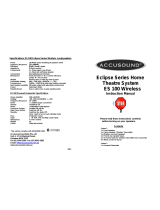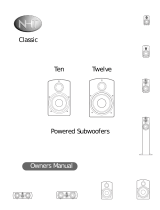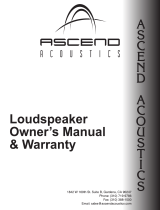Page is loading ...

.
Specifications ES 25 Eclipse Series Loudspeakers
Speaker Specifications:
Power Rating 120 Watts Power Handling
Frequency Response 125~21000Hz
Efficiency 88 dB@1watt 1 Metre
Impedance 8 Ohms Nominal
Components: 2 x 75mm or 3” Paper Cone Drivers
1 x 25mm or 1” Silk Soft Dome Tweeter
Gold plated push terminals
Wall Mount Wall Bracket + Wall Plate
Dimensions 280mm (H) x110mm (W) x95mm (D)
Weight 2.4Kgs
Colours Black Piano Finish
ES 25 Powered Subwoofer Specifications:
Power Amplifier CE Safety Approved 250 watt Continuous
Voltage 240 Volt 50 Hz
Frequency Response 25~200Hz
Driver 1 x 10” or 250mm Woofer
Volume Variable 0~10
Phase Variable 0~180 Degrees
Crossover Control Variable 40~200 Hz
Power Switch Switches Off, On
Fuse Protection 2.5 Amp
Input RCA Socket
Output RCA Socket
Dimensions 430mm (H) x 338mm (W) x 402mm (D)
Weight 20.5Kgs
Colours Black Piano Finish
Accusound Australia Pty, Ltd Unit 3, 17-19 Marshall Road,
Kirrawee NSW 2232 Ph (02) 9545-3905 Fax (02) 9545-3902
Email: [email protected] Website: accusound.com.au
Quality Sound By Design
Eclipse Series Home
Theatre Satellite System
ES 25
Instruction Manual
Read these Instructions before
you connect your speakers

Congratulations! You have just purchased the most important part of a Home Theatre System.
The Accusound ES 25 Eclipse series speakers have been designed in Australia to the closest
tolerances to make this one of the leading speakers on the market today. The ES 25 system will
work on any Digital Receiver on the market. The system will give you solid bass through the
powered subwoofer, clear vocals and crisp top end response from all of the 5 satellite speakers
that many leading brands lack.
Unpacking
If you are reading this, you will have already opened the carton. Fold back the carton flaps and
remove the carton. There are 2 foam inserts. Remove one end, take out the 5 speakers and the
subwoofer. Unpack each speaker from the cloth bag. The cloth bag protects the piano finish. If
you ever move, keep the carton and packing to ensure protection against scratches and
damage.
Room Placement
In a 5.1 set up your front speakers should be positioned on either side of the screen as wide
apart in the room as possible. The centre speaker sits in a horizontal position on or in an
entertainment cabinet facing you. Depending on your room the best position for the left and
right surround speakers are slightly back on either side of your seating position facing you. (this
is position 1 in the diagram). If you have windows and doors in the way, place the speakers in
either corner of the back wall of your room facing up the room. (this is position 2).You should
always look towards the front where the TV is for your position. Front left, centre, front right,
rear surround left is on your left as you look forward and rear surround right. You can place the
subwoofer anywhere in the room. If you decide to run 7.1 you can purchase additional surround
speakers. For 7.2 you can purchase a extra subwoofer from your dealer. You can then set up
as per the complete diagram below. If you are mounting the speakers on the wall, look at our
wall mounting diagram in the instructions.
Room Placement
Wiring Diagram

Speaker Cable
Use good quality Oxygen Free Copper cable. Look for wire with polarity (+ & -) markings on the
outside of the jacket. This will help you determine which wire is the positive and negative at both
the receiver and speaker ends of the cable. This is very important. Red for positive and black for
negative.
Your Receiver
If you have a 7.1 or 7.2 receiver and are only running 5.1 we have found customers connecting the
rear speakers to surround back. This is wrong. Connect your rear speakers to surround terminals.
Surround back is for 7.1 or 7.2
Speaker Connection
On the back of the speakers there are 2 push connection terminals. Red is positive (+) and
Black is negative (-). From your receivers positive terminal connect the wire with the (+)
mark or marking to the Red terminal on the speaker. Connect the negative wire to the
Black terminal.
Subwoofer connection
On the rear panel of the ES 25 powered subwoofer are 2 sockets. The top socket is the
subwoofer input and the bottom socket is the subwoofer output. The output is to connect a
second subwoofer to produce more bass if required. This is .2. Use a good quality subwoofer
shielded cable from the subwoofer out on your receiver. This will stop any interference from
other electrical appliances.
Subwoofer Control Panel
Volume Control
The volume control runs from 0-10. We suggest the volume be set to 5 and then controlled by the
subwoofer setting on your receiver. When listening to movies or music make sure that the subwoofer
does not go into distortion. You can hear this as a distorted crackling sound which is usually caused
when the subwoofer level on your receiver is set too high. Ease the volume back so you get a good
solid bass. This will ensure the subwoofer will play for years to come.
Crossover
The crossover is the heart of the ES40 system. As you turn the crossover control up you add upper
bass. The best set up is to fill the gap between the speakers that can not produce lower bass. At
normal levels the speakers go down to 120Hz. The control starts at 40Hz and goes to 200Hz. We
suggest around 120 Hz to start. You can add or decrease the frequency to achieve the correct
balance for either music or movies. The control only adds higher frequency. It does not alter the low
frequency.
Base Extension
This control adds extra depth to the frequency you have the crossover control set to. We call this
bass extension. The control starts at 0dB which is normal. If you find you are not getting the extra
bass and feeling from the subwoofer you can increase the Bass Extension to get the desired effect.
Phase Control
This function adjusts the phase of the subwoofer driver. This adjustment is required to ensure that
the subwoofer and all other associated loudspeakers operate "in sync." If your main speakers are at
the front of the room the woofers are pushing forward. If your subwoofer is at the front of the room
the woofer will be pushing forward. Turn the phase control to 0. At the back of the room the
subwoofer is pushing in an opposite direction. Turn the phase control to 180 degrees and the
subwoofer will fire in the opposite direction and be in sync. If you place the subwoofer at the side of
the room you run between 40~160 degrees. To hear bass all around the room you will have to adjust
the phase to find the best setting.

Speaker Wall Mounting with bracket supplied
Each speaker is fitted with 3 sockets on the back at the top of the speaker. To use the wall
bracket supplied for straight mounting, screw the inner bracket to the speakers as in Fig 1.
There are 5 wall mount brackets. Mount this bracket on the wall as shown in Fig 2 either using
2 screws for stud walls or 4 screws for solid walls. The flat side with the countersunk screw
holes faces out. Use a level to mount the bracket straight. Attach the self adhesive rubber pad
on the opposite end of the speaker to position the speaker level on the wall. Use 2 pads if you
mount the centre. Slide the speaker over the bracket in Fig 3 on the wall and the job is done.
Fig 1
Fig 2 Fig 3
Speaker Wall mounting with a universal Speaker Bracket (NOT SUPPLIED)
Using the middle socket on the top of each speaker, mount the bracket on the wall screw the
bracket to the speaker as shown in Fig 4
Fig 4
Stand Mount using a universal speaker stand
Most stands have a plate to hold the speaker. Using the screw supplied screw in as shown. If you
purchase Accusound telescopic speaker stands there is a hole in the top of the tube. You can run
the speaker wire through this down the pole to hide the wire,
Breaking In Your Speakers
The Accusound ES 25 Eclipse Series loudspeaker system requires a break-in period to reach
its full potential. This is done by playing music on CD or FM with a wide variety of frequencies
(highs through lows) at a medium volume for at least 30 hours. You can turn the system up
during this time but this is not recommended for long periods. We use high quality
components with tight build tolerances and they require this break-in time. After this period
you will hear a refinement in the bass reproduction and the treble will become clearer and
more defined.
Now it’s time to sit back and enjoy your new Accusound Home Theatre Loudspeaker System.
This is an investment in quality sound reproduction that you will appreciate time and again, for
many years to come. Thank you for choosing Accusound!
/









